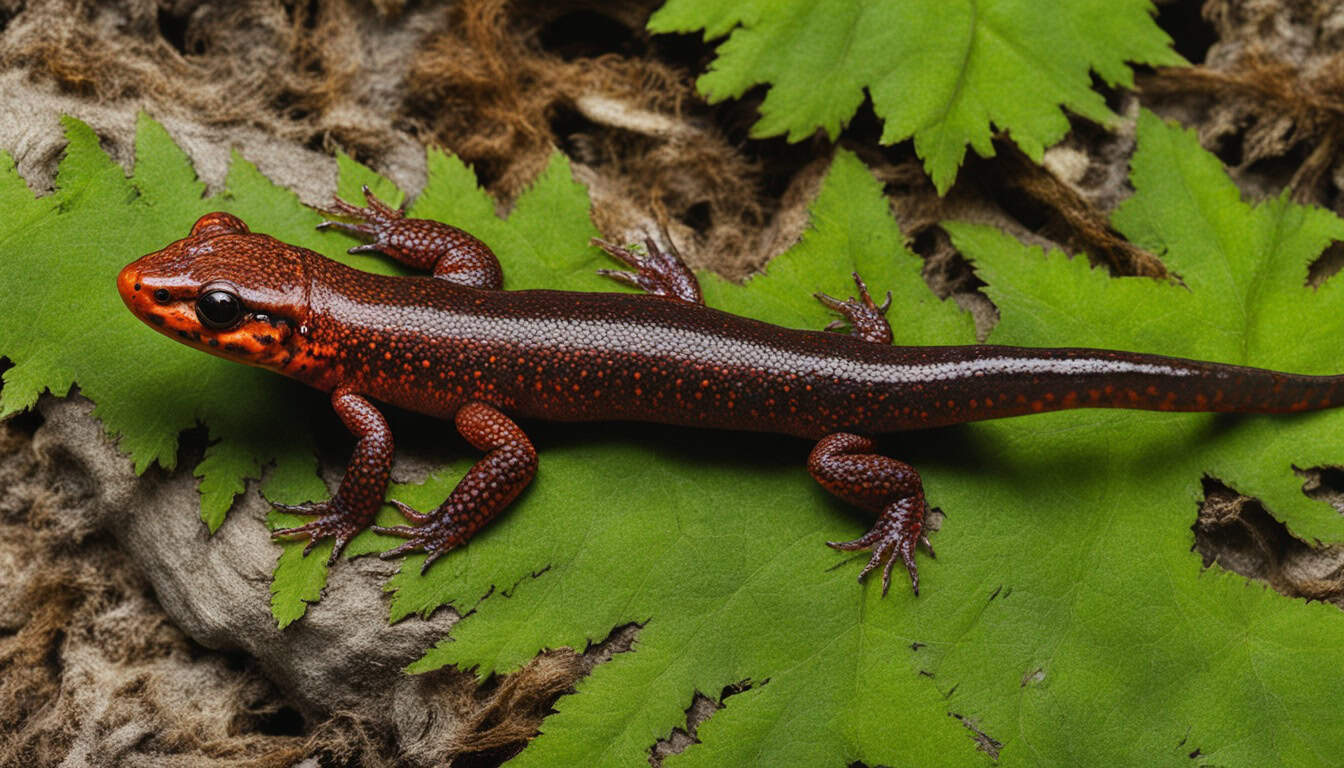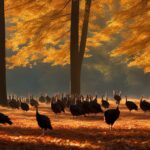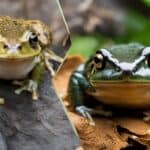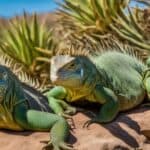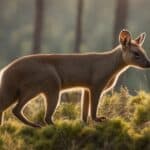You can tell salamanders apart by looking at their physical traits, where they live, and what they do. Salamanders belong to the amphibian group. This means they have skin that stays moist, which helps them breathe through their skin. This makes them different from reptiles, such as lizards. Salamanders are very important in nature. They help keep pest numbers down and are food for some animals.
The USA has many kinds of salamanders, especially in places like the Southern Appalachian Mountains. To correctly identify these salamanders, understanding what makes each type unique is key. This understanding is needed for proper identification.
Understanding Salamanders: Amphibians, Not Reptiles
Many think USA salamander species are like lizards. But they’re closer to frogs, being amphibians. This makes a big difference when looking at what they are.
One key thing is their moist skin. It helps them breathe and stays damp. This is a big part of what makes them different from reptiles. If you’re trying to tell salamanders apart, their skin is a good clue.
USA salamander species are very important in nature. They eat pests and are also food for many animals. Knowing this helps us understand more about them.
Learning about these amphibian characteristics is cool. It shows us how unique USA salamander species are in nature. This knowledge is key for those who want to learn more about salamanders.
Key Differences Between Salamanders and Lizards
Salamanders and lizards have very different characteristics. Most people see them as alike, but each has unique features. These include what they look like, where they live, and how they breathe.
Physical Appearance
Salamanders have moist, soft skin unlike lizards that have dry and scaly skin. Salamanders use their skin to breathe, a feature lizards don’t have. This means salamanders need to stay in damp places to survive.
Lizards, with their dry skin, are better adapted to dry areas. They have strong legs made for running on land. Salamanders need moist places, so their legs are built for moving in the wet.
Habitat Preferences
People often mix up where salamanders and lizards belong. But the truth is, they pick very different homes. Salamanders live in places like wetlands and beside streams and love damp spots. Lizards, on the other hand, prefer drier places, including deserts, to match their dry skin.
Breathing Mechanisms
How they breathe is also very unique. Salamanders can take in oxygen through their skin. This is called cutaneous respiration. It’s a neat trick, but it ties them to moist environments because their skin needs to be wet to work.
Lizards, though, breathe with lungs like we do. This ability lets them live in many places. They do well in dry lands because they don’t need moisture on their skin to breathe.
Hellbender Salamander Identification Guide
Hellbender Salamanders are big and known for their unique looks. They stand out with their large size and wrinkled, slimy skin. This makes it easy to spot them among other salamanders in the USA.
Physical Characteristics
The Hellbender Salamander can grow from 12 to 29 inches. It’s one of the biggest salamanders in North America. They have wrinkled and slimy skin, and keeled tails for swimming. These traits help you identify a hellbender salamander.
Typical Habitats
Hellbenders are mainly found from Southern New York to parts of the Midwest. They love living under big, flat rocks in quick streams and rivers. This environment gives them the right shelter and clean, oxygen-rich water they need.
Behavioral Traits
When looking at USA salamanders, what Hellbenders do can give you clues. They stick to their own rock crevices for a long time, showing they’re very territorial. Even though they have sharp teeth, Hellbenders are not poisonous. They use their teeth to catch food. Their actions and looks make them clearly stand out.
Siren Salamander: A Unique Aquatic Species
The Siren Salamander is an interesting aquatic salamander species. It stands out with its eel-like body. Not having back legs, and having very tiny front ones, makes them special. They are different from other amphibians.
These salamanders are typically green or gray. They have cool ways of living in water. For example, they hide in mud when it’s dry. This helps them live in different places. You can find them mostly along the Atlantic and Gulf coasts.
| Feature | Description |
|---|---|
| Body Shape | Eel-like |
| Upper Limbs | Very Small |
| Hind Limbs | Absent |
| Color | Olive Green or Gray |
| Habitat | Atlantic and Gulf coastal plains |
| Behavior | Burrows in mud during dry periods |
Learning about the siren salamander’s traits helps us spot and admire them. Their special qualities make them fascinating. People who love studying animals and nature find them very interesting.
Identifying the Eastern Newt: Stages and Features
Knowing how to tell salamander kinds apart is big for fans and experts. The Eastern Newt, especially, is a standout. It’s famous for how it changes during its life, known as metamorphosis.
Life Cycle Stages
The Eastern Newt goes through three big life shifts: first, they live in water as larvae, then move on land as teens (that’s the red eft phase), and finally go back to water as adults. When they’re babies, they look much like other water-living salamanders, but with gills. When they grow into teens, they turn a striking orange or red. This helps us pick them out from the rest. As adults, they darken to an olive-green and have a yellow stomach with black spots.
Physical Traits
Looking at the Eastern Newt’s colors and features is key to figuring out what stage of life they’re in. They start off as very bright red efts, then turn greenish as adults. All through their lives, they have smooth, wet skin and flat tails that help them swim. These details really stand out. They help both fans and experts know which life stage of the Eastern Newt they’re seeing in nature.
Natural Habitat
The Eastern Newt loves the Eastern United States. It lives in water and on land, depending on its age. Teen efts are found in damp forests, under logs and leaves. Grown newts live in ponds, lakes, and slow rivers. Knowing where they live is essential for spotting them and understanding their place in nature.
| Life Stage | Color | Habitat | Key Features |
|---|---|---|---|
| Larvae | Greenish Brown | Aquatic | Gills, Slender Body |
| Juvenile (Red Eft) | Bright Orange/Red | Terrestrial | Bright coloration, No gills |
| Adult | Olive Green | Aquatic | Paddle-like tail, Spots |
How to Differentiate the Marbled Salamander
The Marbled Salamander is uniquely marked and quite easy to spot. Its scientific name is Ambystoma opacum. This species can be easily told apart from others in the US. It has its own special looks and lives in specific places.
Distinctive Markings and Size
Marbled Salamanders have distinct looks. They are small, measuring 3.5 to 4.25 inches long. What makes them stand out is their white or gray crossbands against a black background. These markings help you find them in nature.
Preferred Ecosystems
They love wetlands and moist woodlands in the Eastern US. You can find them from the South of New England to Texas. They live in damp areas like forests and by water. There, they often hide under things, staying safe from harm.
Knowing about the Marbled Salamander and where they live can help you spot them. They are fascinating, unique creatures living in the wild.
Spotting the Spotted Salamander: Key Identifiers
Looking at different salamanders in the USA, it’s important to spot key traits for each kind. The Spotted Salamander stands out with its yellow or orange spots on a blue/black body. It’s big and can reach a length of about 9 inches. Their skin is smooth to the touch.
Their home is mainly in the East of the USA. They live in places like under rocks or in forest nooks. This keeps them safe from predators.
| Characteristic | Description |
|---|---|
| Spots | Yellow or orange spots along the body |
| Body Color | Blue/black |
| Skin Texture | Smooth |
| Length | Up to 9 inches |
The Spotted Salamander adds to the beauty of USA’s salamander world. Learning about these traits helps us appreciate the many salamander types in the area.
The Rare Black Warrior Waterdog
The Black Warrior Waterdog is a fascinating creature from Alabama’s Black Warrior River basin. This special endemic salamander species looks like a larva its whole life, complete with bushy gills. Keeping larval traits as an adult is called neoteny.
This waterdog is usually brown with dark stripes from its nose to its gills. It is clearly unique in its appearance.
The Black Warrior Waterdog habitat is only found in the Black Warrior River area. Its surroundings are vital for its existence, making it a rare find. It’s important to protect its home for the waterdog to survive.
Let’s take a quick look at the Black Warrior Waterdog:
| Feature | Description |
|---|---|
| Size | 7-11 inches |
| Color | Brown with dark stripes |
| Habit | Fully aquatic, often remains hidden during the day |
| Location | Black Warrior River basin, Alabama |
| Notable Feature | Retains larval gills throughout life |
Conservation Efforts for Salamanders in the USA
To keep salamanders alive in the USA, we must work together. This involves fighting against dangers and keeping their homes safe.
Threats to Salamander Populations
Salamanders are in danger due to losing their homes. Cities, cutting down trees, and making the water dirty have hurt their living spaces. Changes in weather and sickness are also big threats. Without special plans to help them, salamanders might not make it.
Steps for Conservation
We need to take specific steps to save these creatures. Here’s what we can do:
- Lessen how much people hurt the places salamanders live through laws and careful use.
- Work to save and fix areas like wetlands and forests where they can live.
- Help groups that work only to save salamanders.
- Tell others how important it is to protect wildlife in the USA.
By working together, we can fight dangers and help salamander families grow.
Importance of Habitat Preservation
Keeping their natural homes safe is key to the salamanders’ survival. Wetlands and forests are like their perfect home, full of the right water and hiding places. Protecting where they live also helps many other animals by keeping nature diverse and healthy.

| Threat | Impact |
|---|---|
| Habitat Loss | Major reductions in populations due to loss of wetland and forest areas. |
| Pollution | Water and soil contamination affecting health and reproduction of salamanders. |
| Climate Change | Altering habitats and breeding patterns, causing stress on populations. |
| Disease | Infectious diseases like chytrid fungus threatening many species. |
Resources for Further Salamander Identification
If you want to get better at telling different salamander types apart, lots of good resources can help. Look for books by experts in the field. These books give you all you need to know about a salamander’s look, where it likes to live, and how it acts. You can start with titles like the “Peterson Field Guide to Reptiles and Amphibians of Eastern and Central North America” and the “National Audubon Society Field Guide to Reptiles and Amphibians: North America.”
Another good idea is to use online databases. Sites like iNaturalist and AmphibiaWeb have a wealth of salamander info and pictures. You’ll find user reports that make identifying these animals a shared, community effort.
Getting involved with local groups is also very helpful. Organizations like the North American Center for Conservation Bioacoustics and local clubs often have hands-on activities. These include workshops and trips outdoors. By joining these events, you not only learn more but also help out with science projects. These projects aim to better understand and protect salamanders.
By using a mix of these resources, you can really up your salamander knowledge. This not only helps with telling one type from another, but it also supports their conservation. This way, you play a part in keeping these amazing creatures safe and sound in the wild.
FAQ
How do you identify different species of salamanders in the USA?
To tell salamander species apart in the USA, look at their looks, homes, and actions. You can check their skin feel, color designs, and how big they are.
What distinguishes salamanders from reptiles like lizards?
Salamanders’ skins are moist and soft, whereas lizards have dry, hard skin. Salamanders need damp places because they breathe through their skin.
What are some key traits of the Hellbender Salamander?
The Hellbender is large, with slimy skin, and a special tail. It lives under rocks in streams from Southern New York to the Midwest.
What makes the Siren Salamander unique?
The Siren looks like an eel with no back legs. It thrives in water but can dig into mud when it’s dry. You can find it along the Atlantic and Gulf coasts.
How can you identify an Eastern Newt?
The Eastern Newt changes in looks as it grows, starting orange then turning green. It lives in water and on land in the East of the USA.
What are the distinguishing features of a Marbled Salamander?
Marbled Salamanders are chubby with patterns that vary from white to gray on black. They like wetlands and forests in the Eastern U.S.
How can one spot a Spotted Salamander?
Look for a Spotted Salamander by its yellow or orange spots and dark body. It’s smooth and can get pretty big. You’ll find them under rocks or in burrows within Eastern forests.
Where is the Black Warrior Waterdog found?
The Black Warrior Waterdog lives in Alabama’s Black Warrior River basin. It looks like a young salamander even when it grows up, with stripes on a brown body.
What are the main conservation threats to salamanders in the USA?
Habitat loss is the big threat to salamanders in the USA. To help them, it’s important to save forests and wetlands, reduce our human impacts, and inform people about their needs.
What resources are available for further salamander identification?
For better salamander spotting, try using guides and online databases. Also, get involved with local wildlife groups. They teach a lot about caring for salamanders.

